Reclaimed Full Bed Stone Veneer
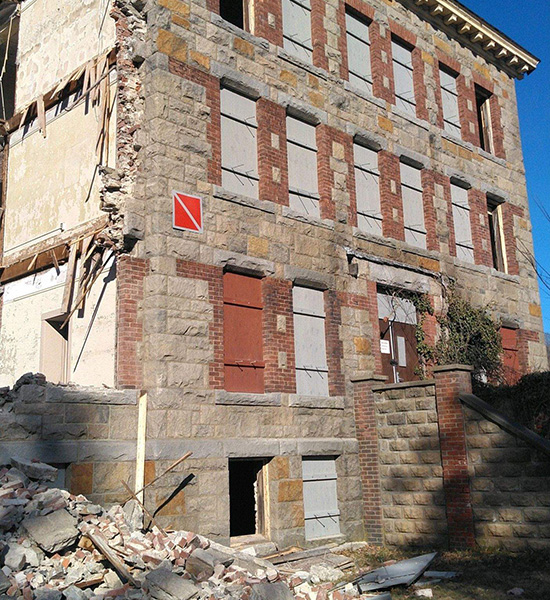
Despite the best efforts to preserve them, sometimes historic buildings come down. Stone Farm makes every effort to identify these buildings and salvage material such as antique stone veneer. The process is consistent with the goals of a sustainable future, but it also ensures that the legacy of the renowned architects and master craftsmen who built them can carry on in new construction and design.
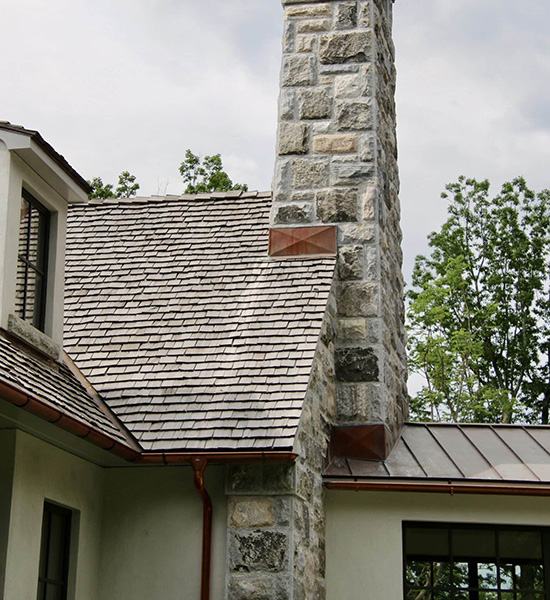
Sign up for news!
Sign up for our Farm Fresh Finds newsletter, where we announce the arrival of newly salvaged material to our yard,
RECLAIMED STONE VENEER REVEALS COLORS NEWLY QUARRIED STONE CANNOT
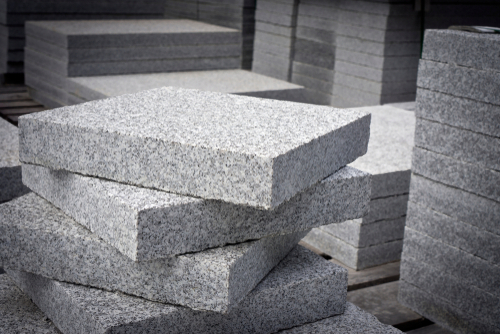
FRESHLY QUARRIED STONE
From classic New England granite's earthy salt and peppers, to upstate New York limestone's subtle shades of blue and brown, to the creamy whites unique to marble-freshly quarried stone's colors are determined by how and where it was formed.
However, once used in the construction of a building, exposure and wear can produce changes to that stone which can't be duplicated. The effects of the elements, time and human contact all affect the look of the antique stone you'll find here at Stone Farm.
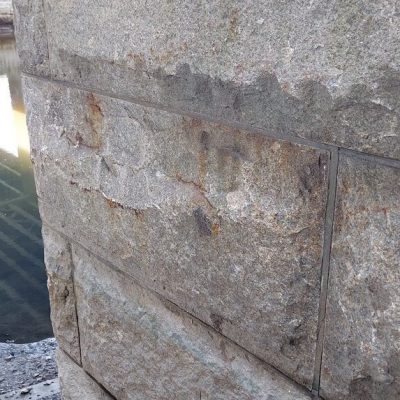
OXIDATION
Minerals in the stone reacting with oxygen in the air or rainwater can result in the rust colored streaks found in some reclaimed stone veneer.
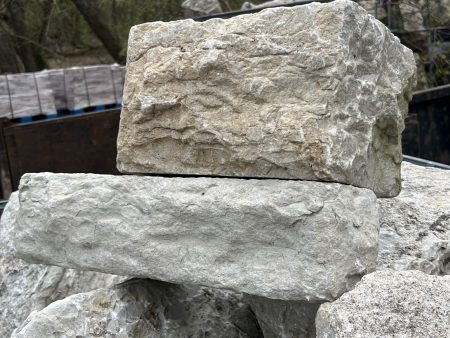
PATINA
Exposure to water acidity, organisms such as algae, moss and lichen, and processes like evaporation are among the factors that result in a film on the stone surface. Patina colors can vary, but shades commonly found on our reclaimed stone veneer range from greens and yellows to browns and oranges.

If you're an architect, designer, or are in a related field which requires you to earn CE credits, please consider taking our online Continuing Education course:
RECLAIMING HISTORIC BRICK & STONE FOR MODERN APPLICATIONS.
It's approved by several organizations, including the AIA and ASLA.
ANTIQUE STONE VENEER DIMENSIONS
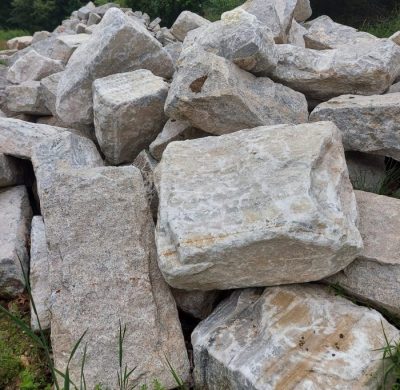
Modern full bed veneer is typically in the 3"-6" range. However, since we salvage older buildings, our reclaimed full bed stone veneer can be as thick as 18".
We often split this stone and separate out the weathered/worked faces. Ideally, we can use the backs to mix into the same project, or set them outside for other projects altogether. Additionally, these deep pieces could be ideal for stone walls where the veneer can be worked directly in, with no splitting necessary.
FULL BED STONE VENEER VS. THIN STONE VENEER



The differences between reclaimed full bed stone veneer and thin stone veneer stem from their relative thickness:
- Thin veneer is usually sawn to a thickness of .75-1.5 inches. As mentioned above, modern full bed ranges from 3-6" in depth. So since our reclaimed stone can be as thick as 18", we will split or saw it to achieve the proper depth for either full bed or thin.
- Because of its heavier weight, full bed stone (often referred to as building stone) usually requires an anchoring system for installation, while thin veneer can be installed with a regular mortar bed.
- Full bed stone veneer is more durable and weather resistant. While both are relatively easy to maintain, thin veneer is more prone to cracking and chipping.
- Full bed stone veneer is more commonly used for exterior walls. Together with its superior durability, it provides better insulation.
- While thin stone veneer has traditionally been a more common choice for interior projects such as accent walls and fireplace surrounds, it's popularity as an exterior option has increased due the costs associated with full bed veneer, such as shipping and installation fees, along with the need for highly masonry work.
ANTIQUE STONE VENEER MOCK-UPS
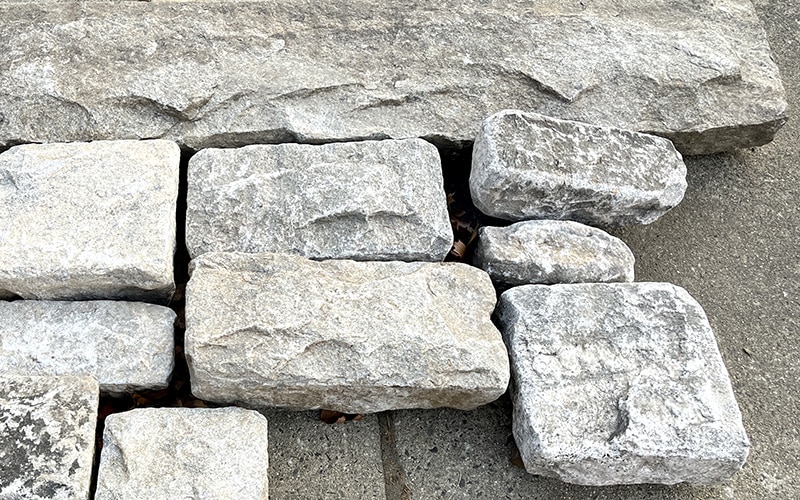
At Stone Farm, we love to see how the different reclaimed stone veneers in our yard work together in blends. We create mock-ups to see what is possible for our customers.
In this rough mock-up, we laid out a blend of stone veneer beneath a piece of reclaimed granite curb the client was considering as a header. Curbing works well as an accent to other reclaimed stone, as well the main component for a variety of projects. Visit our curbing page to learn more.
Sometimes stone veneer mock-ups are completed at the construction site. Color, facing, cut and mortar are considered to ensure the design matches the client's desired look.
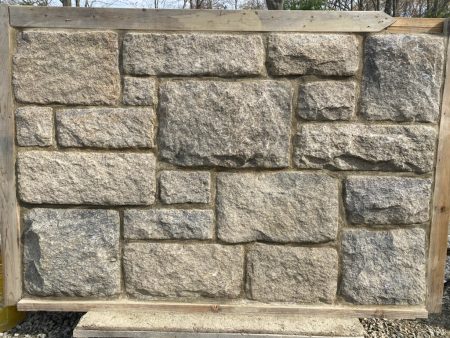
RECLAIMING HISTORY: ST. JOSEPH’S CHURCH-NEW YORK CITY
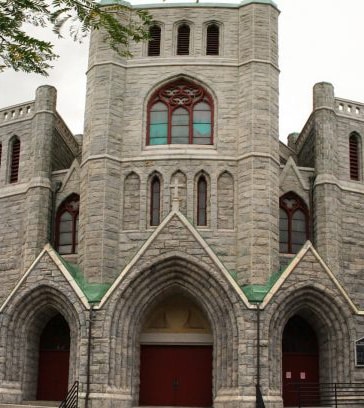
When we learned in 2021 that this iconic Bronx institution was set for demolition, we were determined to salvage as much of its beautiful building stone as possible. The neo-Gothic church was built between 1898 and 1904, replacing a smaller church built only 25 years earlier. It's growing congregation, mostly German and later Irish immigrants, necessitated a larger building, and mirrored the population explosion occurring throughout New York City.
The church was built with white marble quarried from the very site of it's construction, as well as locally sourced granite, which provided the facing of it's front and rear facades. The pieces we salvaged were quite large, consisting of a roughly 60/40 split of granite to marble.
Cutting these beautifully faced stones to workable depths for full bed veneer, and utilizing their backs for fill ensures that St. Joseph's legacy didn't end with it's demolition, and instead lives on in new projects and applications.
INTERESTED IN RECLAIMED FULL BED STONE VENEER?
Include photos, square footage and as much information as you can about your project and we will get back to you as soon as we can.
